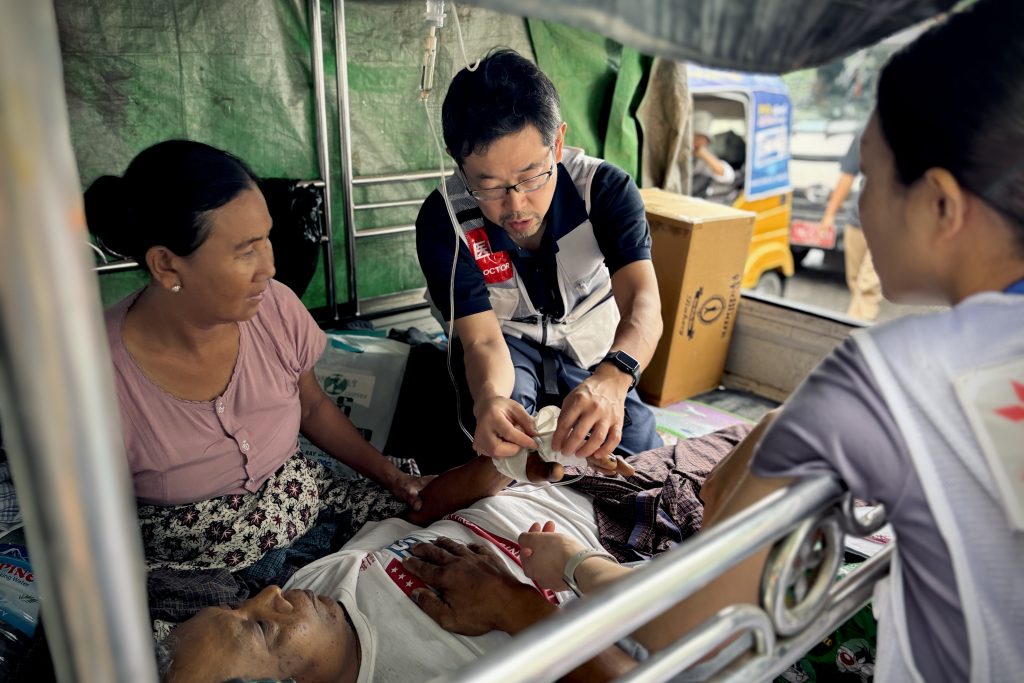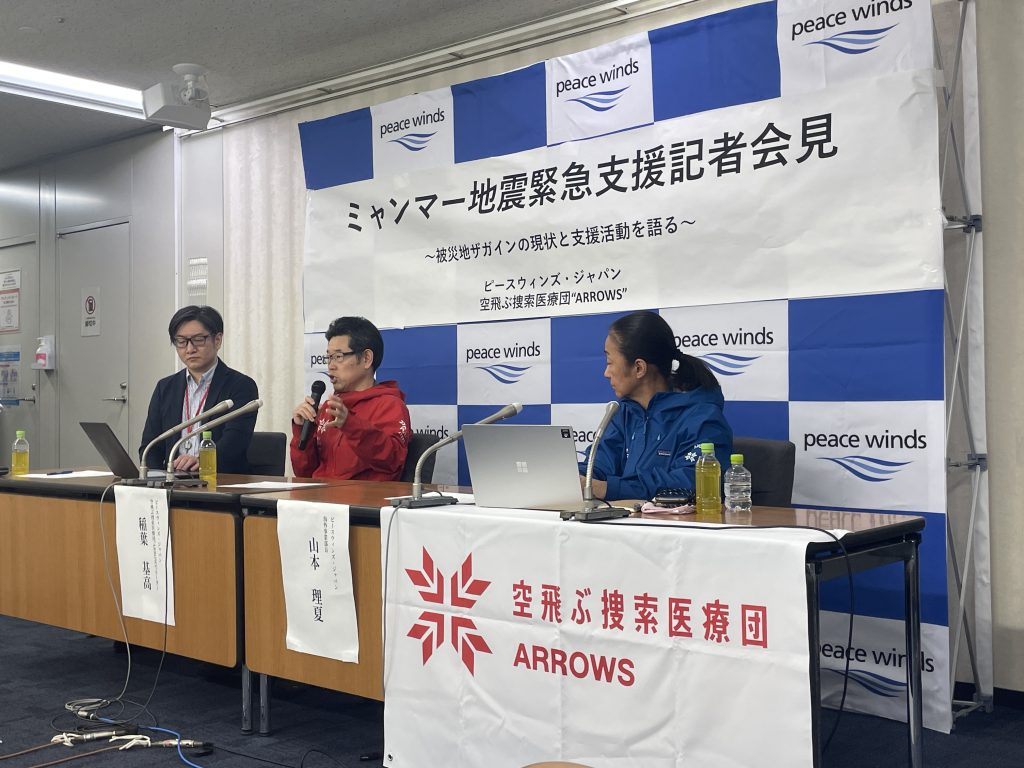Myanmar emergency team reflects on hardships of earthquake response

Peace Winds recently hosted a press conference to discuss its Myanmar earthquake response. The head of Peace Winds’ emergency medical team, Dr. Mototaka Inaba, and Rika Yamamoto (Director of Overseas Programs) spoke about why this disaster has proven uniquely challenging for both survivors and those providing relief.
After the 7.7 magnitude earthquake struck on March 28, Peace Winds dispatched its disaster medical team–including Dr. Inaba, three nurses, logisticians, and others–to aid survivors. The Myanmar military government’s restrictions made it difficult to obtain visas, so the team entered the country about a week after the disaster. It was one of few international medical groups to do so, in addition to Chinese, Russian, and Indian teams. Peace Winds staff set up a field clinic at the epicenter in Sagaing and treated survivors who were desperately in need of medical care.
Seasoned disaster responders, including Dr. Inaba, were shocked by the level of devastation that still remained one week after the earthquake.
“In Japan, it is unthinkable that people would still be sleeping on the streets one week after a disaster,” he said. “But when we got [to Myanmar], so many people were sleeping on tarps out in the open in front of their collapsed homes.”
Dr. Inaba has responded to disasters in Japan and around the world, including the February 2023 earthquake in Türkiye and the 2024 New Year’s Day earthquake on Japan’s Noto Peninsula.
“I started treating patients on site the day after the Noto Peninsula earthquake. After a week, there were hardly any patients with fractures or other problems,” Dr. Inaba said.
In Myanmar, however, he and the team spent about two weeks treating nearly 200 patients for broken bones, open wounds, and infections that had gone untreated for a week or more.
“Several patients with fractures who still had not seen a doctor came to see me. Some people had been at home for a week with open fractures, which is when the bone is broken and protruding out of the skin. There is a risk of infection and death when these are left untreated. In Japan, the general rule is to perform emergency surgery within six hours.”
Myanmar’s political situation was a major contributing factor.
“Usually when an earthquake of this magnitude happens, many international aid and medical teams are sent in,” Dr. Inaba said. “But with this disaster, only aid workers from a limited number of countries were given permission to enter [the country]. We were the only team that was able to work in Sagaing, which was the hardest-hit area. The political situation made it difficult for so-called Western teams to even enter places close to the epicenter like Mandalay. I think that cast a shadow over the efforts to deliver aid.”
Myanmar’s hot, humid climate also made conditions difficult for survivors and aid workers. In addition to injuries, Dr. Inaba and his team treated a number of patients for dehydration and heat-related illnesses.
“We worked in tents,” he said, “but we often couldn’t get the air conditioners to work. It was [100° to 102°F] inside the tent. We turned on a fan, but it just blew in hot air. And the humidity was 70%, so the conditions were quite harsh.
“Sagaing was in a state of conflict, and even before the earthquake, there was only about an hour of electricity a day,” Dr. Inaba recalled. “There was not enough running water either. How were we supposed to deliver medical care with such limited resources?
“People in Sagaing normally used generators, but after the earthquake, it was hard to get fuel. We expected this, so we brought large batteries with us that powered the medical equipment. But we didn’t have enough power to run the air conditioners.”
In addition to medical care, Peace Winds has been providing survivors with basic emergency supplies.
“We have prepared and distributed sets of food and hygiene products, and daily necessities such as blankets and mosquito nets,” said Ms. Yamamoto, who continues to oversee the response. “We’re continuing to distribute those types of things. We conduct interviews on site and adjust our activities to make sure that they don’t overlap with what local people and organizations are doing. That way survivors get what they really need.”
Dr. Inaba emphasized how critical the need for humanitarian aid will be in the long-term. “We drove back and forth between Mandalay and Sagaing every day, and we could clearly see how hospitals were overwhelmed, patients had a hard time getting the surgeries they needed, and beds had to be lined up outside the hospitals.
“After the emergency trauma stage, disaster-related illnesses and mental health challenges will become more prominent,” he said, referring to a phenomenon in which trauma survivors develop physical and mental illnesses that go untreated. Many people can develop depression or even commit suicide. “I think we will be entering a phase where mental health care is extremely important.”
Dr. Inaba shared the heartbreaking story of one patient he met in Myanmar. “There was a young couple who had fled to Sagaing to protect their children from the war, but the earthquake struck shortly after, and both children died. The father, who is in his 20s, suffered serious injuries to his leg, but he was so distraught about losing his children that he didn’t seek medical care for a week. His wounds were quite severe, but he told me his story as I treated him. I have three children of my own, so that hit really close to home.
“There was another man who told me that he had been praying at a mosque when the earthquake occurred, and 37 people there died. He was one of a few survivors. Some people had horrific experiences even if their physical wounds weren’t too serious.”
Both Dr. Inaba and Ms. Yamamoto urged people not to lose interest in helping Myanmar’s earthquake survivors. Ms. Yamamoto affirmed Peace Winds’ commitment to providing aid for the long-term.
“I think that in the near future, aid will shift from supplies to focusing on how to rebuild destroyed schools and homes,” she said. “We can’t do everything, but we would like to continue our activities so that we can meet communities’ needs for as long as possible.”
Your donations will help Peace Winds continue its life-saving work.
Additional Updates from Myanmar
- Distributing emergency supplies for Myanmar earthquake survivors (April 25, 2025)
- Long-term aid needed in Myanmar for survivors who face an uncertain future (April 16, 2025)
- Urgent Medical Care for Earthquake Survivors in Myanmar (April 10, 2025)
- Peace Winds Responds to Deadly Myanmar Earthquake (March 29, 2025)
